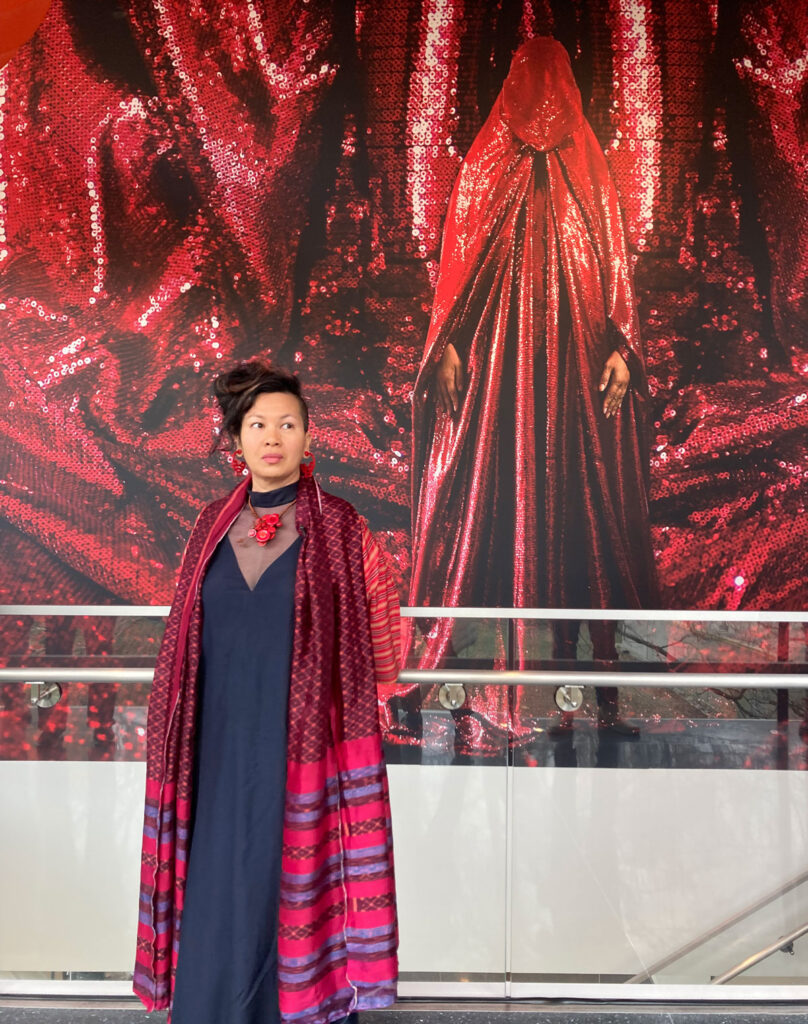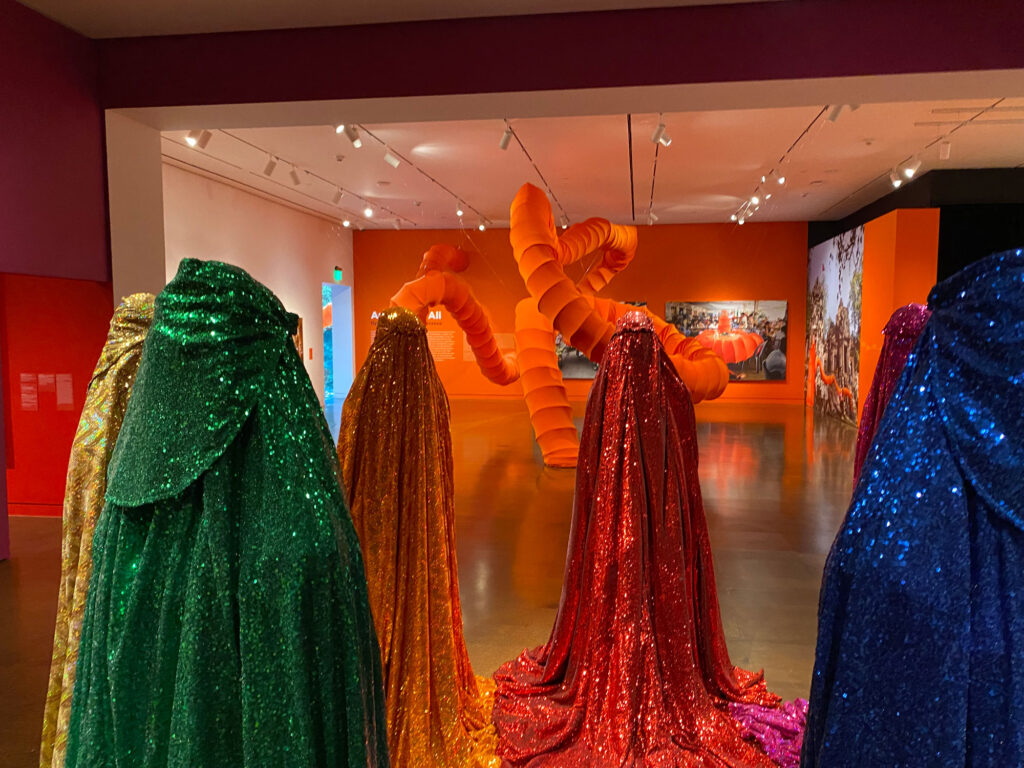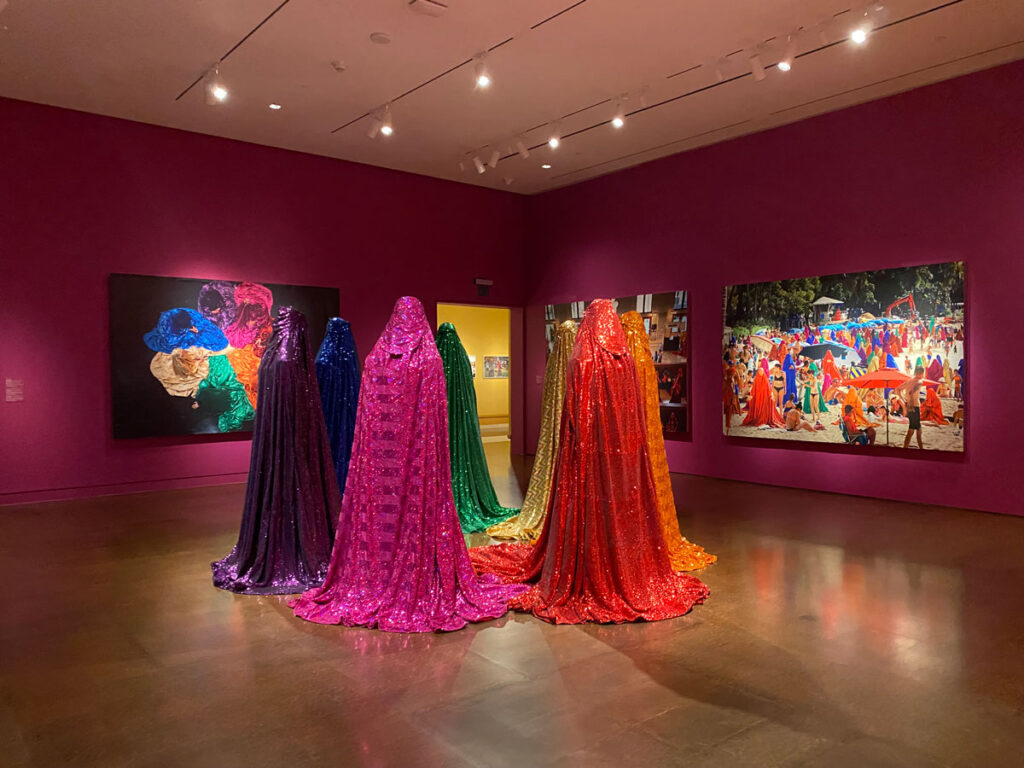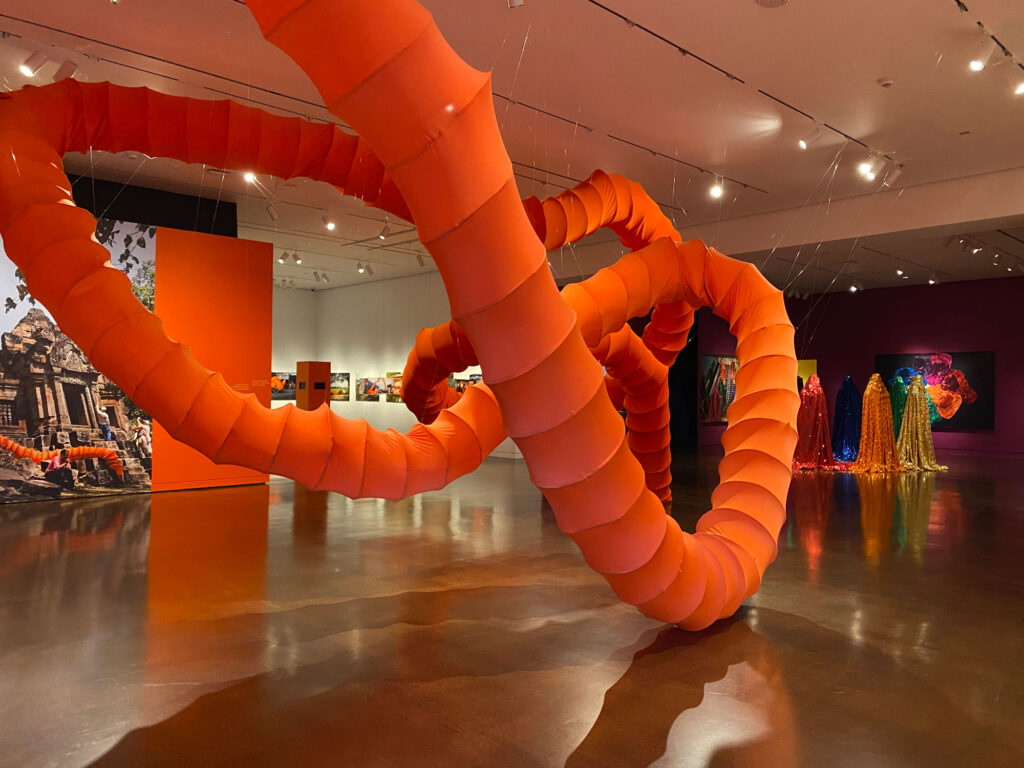Performance art requires a specific time and place. It’s an event, in and of itself. And each performance is a one-of-a-kind experience.
This, says Anida Yoeu Ali, senior artist-in-residence at the University of Washington Bothell’s School of Interdisciplinary Arts & Sciences, is part of what makes performance art special.
“Performance art can happen anywhere, anytime, by anybody,” she added. “You don’t need permission to do performance art. That’s what I love about it.”
In her first solo exhibit at the Seattle Asian Art Museum, “Hybrid Skin, Mythical Presence,” Ali will be again presenting and performing two of her iconic works — “The Buddhist Bug” and “The Red Chador.” Together, these two pieces represent 14 years of the Tacoma-based artist’s career.
“SAM is thrilled to be working with Ali on this exhibition, which marks her SAM debut and the first solo show of a Cambodian American artist in SAM’s history,” said José Carlos Diaz, curator of the exhibit, in a press release. “It’s also the Seattle Asian Art Museum’s first solo show for an artist since the museum reopened in 2020. It’s very exciting that these important firsts for the museum center on such dynamic and compelling work that tackles such relevant themes including the hybrid nature of identity.”
Finding her voice
In her latest exhibition, Ali explores her hybrid transnational identities, a recurring theme throughout much of her work. A first-generation Muslim Khmer woman, Ali was born in Cambodia and later raised in Chicago after her family was displaced by the Cambodian Genocide that occurred under the rule of the Khmer Rouge from 1975 to 1979.

Although Ali now uses her work as a platform for social and political activism, she said it wasn’t until college, where she learned about Asian American history, that she found her voice. “Aligning myself to that history and that knowledge helped me to break out of my shell,” she said.
Her first foray into performing happened when she began writing poems to read aloud.
“Because people gave me so much love and adoration, and really vibed with the things I said, it gave me the courage to keep going up on stage — and that’s what really did it for me,” she said. “That spark grew from there, and I began bridging the visual and the performing arts.”
Ali received her BFA in Graphic Design from the University of Illinois Urbana-Champaign and an MFA in Performance from the School of the Art Institute of Chicago.
Equipped with a new medium and a means to explore her identity and her voice, Ali returned to Cambodia as a Fulbright scholar in 2011. During her residency in Phnom Penh, Cambodia, “The Buddhist Bug” — a work in which Ali dons the body of a 100-meter saffron-colored creature — was born out of her investigation into displacement and identity within her own personal experience and those around her.
Near the end of her residency in 2015, Ali said she then birthed “The Red Chador.”

Reimagining otherness
In “The Red Chador,” Ali reimagines the garment known as a chador (a dark, full-body cloak worn by some Muslim women) as a red sequined gown — a debutante dress for the Orthodox Muslim woman, she said.
She uses this work to explore themes of “otherness” and of Islamophobic fear and perceptions that Muslim women often face due to the hypervisibility of the garment as a symbol of their faith.
In 2016, after Donald Trump was elected president, she recalls being filled with shock as she feared a ban on Muslims in the U.S. would soon become a reality. So she donned the garment and held a sign reading “Ban Me” as she performed in various places around Seattle, including Pike Place Market.
“I did the only thing that I felt exemplified who I was,” Ali said.
She was overwhelmed by the audience response. “So many people came up to me crying and whispering, ‘We stand with you.’ They understood that it was a politicized moment and the gravity of what some of us were experiencing.”
While not all the reactions were positive, audience engagement is nevertheless integral to her work, Ali said. She recalls one moment that felt particularly impactful, when a woman wearing an IV drip in her backpack walked alongside her for as long as her health would allow, only a few blocks. The woman had made her own sign that read, “Not on my watch,” using a manila folder and a marker.
“As a performance artist, part of the work is that you’re putting your body out there with a sense of courage, honesty and authenticity,” Ali said. “I didn’t expect such empathy or that people needed that cathartic moment. It was very powerful.”

Inspiring the next generation
As senior artist-in-residence at UW Bothell, Ali enjoys teaching as another kind of performance and as yet another way to engage with and inspire others through art.
“I love influencing the next generation of creatives,” Ali said. “I find myself in a very inspiring and powerful position to instill passion, joy and a sense of accomplishment in my students when they create works they didn’t imagine they could do in the beginning of the class.”
Senior Interdisciplinary Arts major Ezra Bantum said he loves Ali’s work and her passion for creating art that inspires thought and change in the world. So when she asked him to be her student assistant, he jumped at the opportunity.
“As an artist, what excites me the most about Professor Ali’s work is its boldness in how it takes up space, both physically and culturally,” he said. “She has a special way of pinpointing a pressure point within a culture, community and political atmosphere — and creating art that presses on that point in just the right way, where it challenges our perspectives and forces us to think.”
In the year-and-a-half that Bantum has worked with Ali as her assistant, he has learned a lot about himself as an artist and applied the experience to his own work.
“The biggest thing I’ve learned when working with Professor Ali has been, when you think you’re done, you’re probably at least five drafts or versions away from your best work,” Bantum said. “She has taught me to push myself further, and I’ve learned I’m capable of more than I thought.
“Learning what art is and how it can be lived out in such a beautiful way through the life of Anida Yoeu Ali has been truly inspiring.”
I love influencing the next generation of creatives. I find myself in a very inspiring and powerful position to instill passion, joy and a sense of accomplishment in my students when they create works they didn’t imagine they could do in the beginning of the class.
Anida Yoeu Ali, senior artist-in-residence, School of Interdisciplinary Arts & Sciences
Celebrating hybridity
“Hybrid Skin, Mythical Presence” is on exhibit at the Seattle Asian Art Museum through July 7, 2024. It includes video, photography and other installation pieces from previous performances in various site-specific locations.
The local community also has two opportunities to experience Ali’s live performances.
On March 23, Ali will perform “The Buddhist Bug” at the museum. On June 1, together with six participants, she will perform “The Red Chador: Afterlife” on the streets of downtown Seattle, linking together the museum’s three locations: the Seattle Art Museum, the Olympic Sculpture Park and the Seattle Asian Art Museum.
“I want people to know — whether it’s audiences who will see themselves within this work or audiences who don’t connect at all to the work — that somebody like me exists in this world. I think it’s a powerful place to be in this position and to celebrate hybridity,” Ali said.
“People aren’t going to understand everything about my work, and I think what’s so powerful about contemporary art is that it makes us ask more questions of what we’re seeing and experiencing.”





